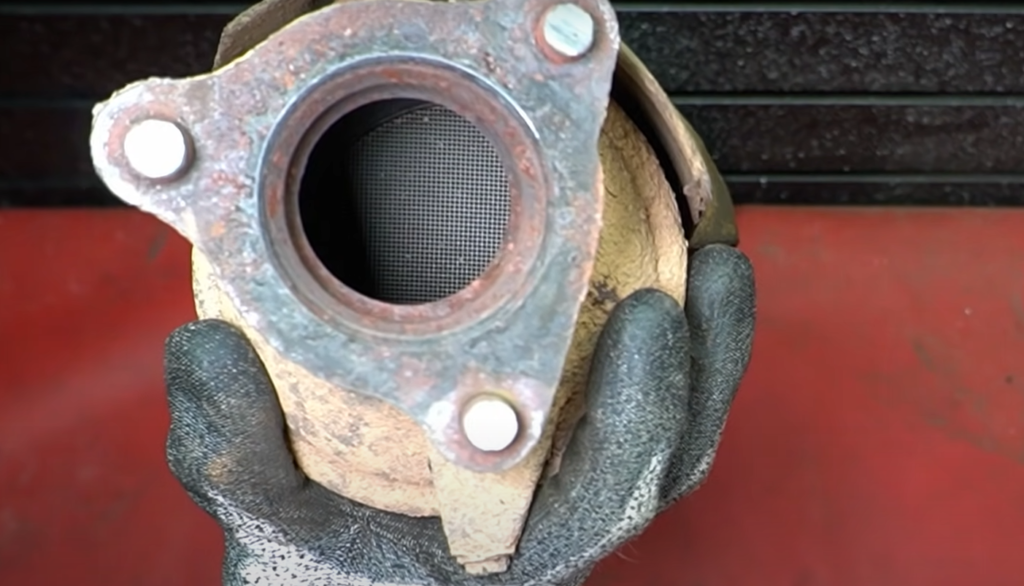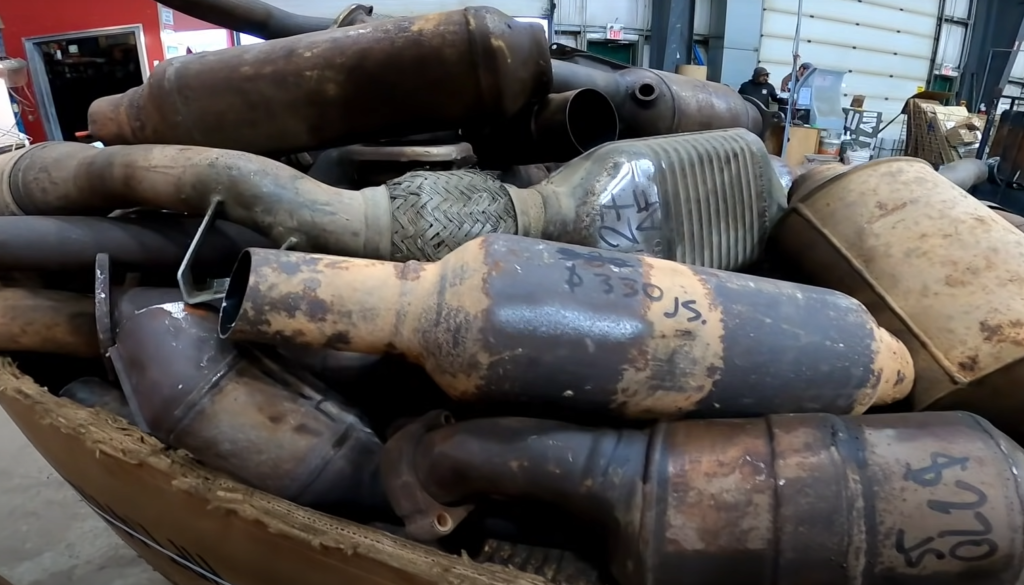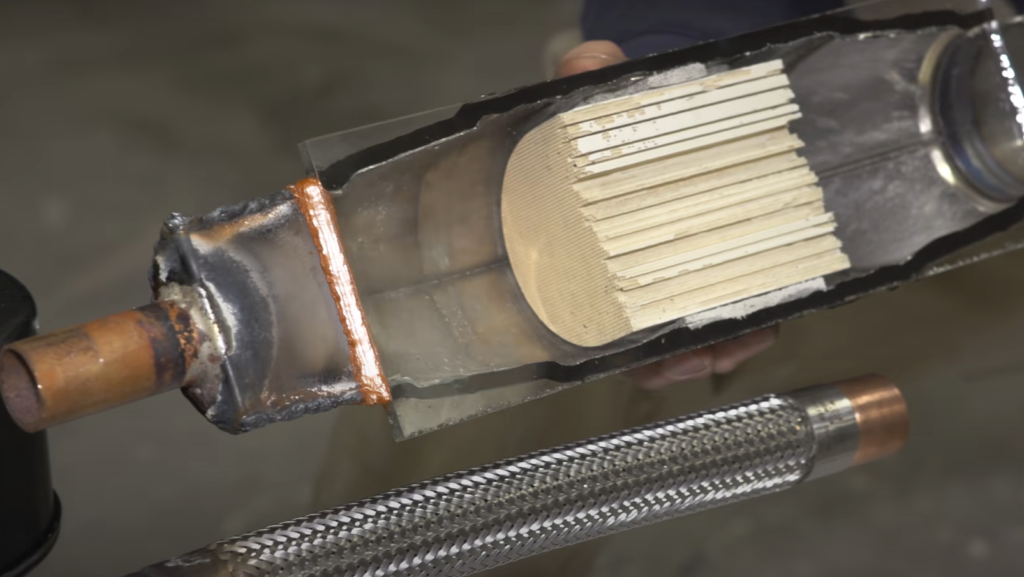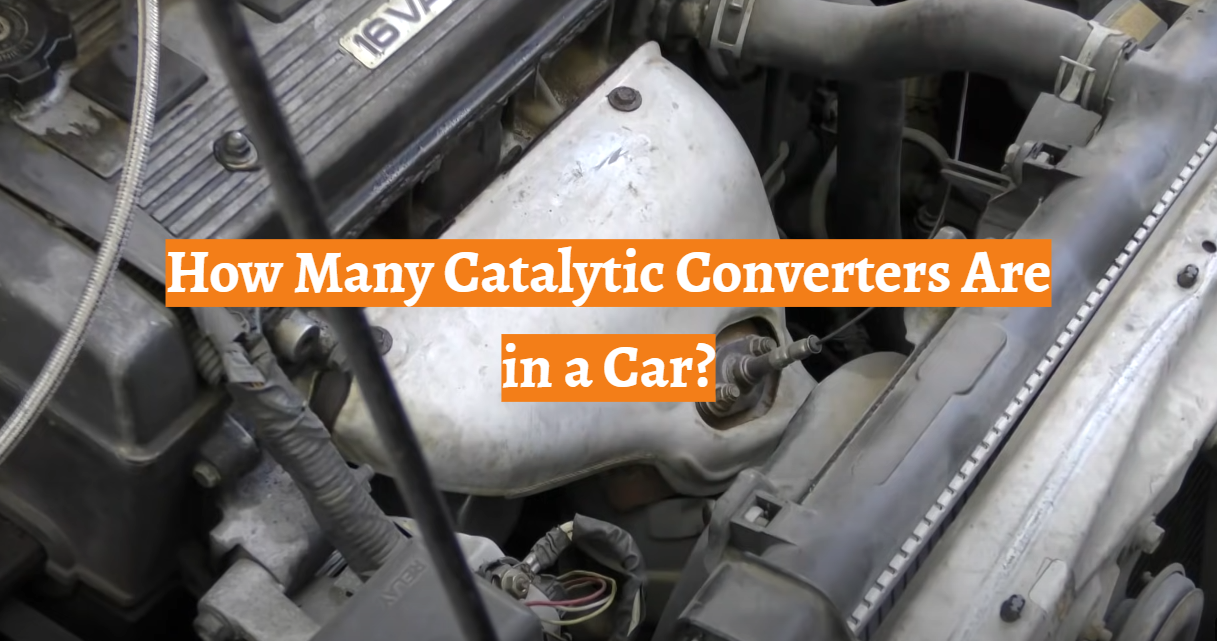Do you know how many catalytic converters are in your car? If you don’t, you’re not alone. Most people don’t know this information, but it’s important to know. Catalytic converters play a very important role in keeping our air clean. This blog post will discuss the role of catalytic converters in cars and what happens when they fail. It will also talk about how to tell if your catalytic converter needs to be replaced.
How Does The Catalytic Converter Work?
The catalytic converter works by using a combination of different metals, like palladium and platinum, to act as a catalyst. This enables the chemical reactions that take place inside the converter to happen much more quickly than they would without the metal present. The metals are finely ground into a powder and placed in between two ceramic blocks with small air channels for oxygen and exhaust gasses to pass through.
As the exhaust gasses pass through the catalyst, any pollutants are broken down into harmless compounds such as carbon dioxide and water vapor. Oxygen is also introduced into the mix which helps speed up these reactions even further. The result is cleaner emissions from your vehicle and better fuel economy due to improved combustion efficiency.

The catalytic converter is an essential part of modern vehicles and helps to reduce the impact they have on the environment. It also plays an important role in improving engine performance, as well as providing increased safety for drivers and passengers when traveling.
In summary, a catalytic converter works by using metals such as palladium and platinum to speed up chemical reactions which convert pollutants into harmless compounds like carbon dioxide and water vapor. This helps reduce emissions from cars and improves fuel economy while increasing driver safety. Regular maintenance should be performed to make sure your catalytic converter is working efficiently [1].
Types Of Catalytic Converters
Two-way Catalytic Converters
Two-way catalytic converters are the most common type of catalytic converter and are used to reduce both carbon monoxide (CO) and hydrocarbon (HC) emissions. In this type of converter, a ceramic honeycomb or metal substrate with a coating of noble metals such as palladium, platinum, and rhodium is used to facilitate the oxidation of CO and HC into harmless substances.
Three-way Catalytic Converters
Three-way catalytic converters are used on cars that have gasoline engines. These converters use a combination of platinum, rhodium, and palladium to oxidize CO and HC while also converting nitrogen oxides (NOx) into nitrogen and oxygen. This type of converter is more efficient than two-way converters, but they are also more expensive to manufacture.
Diesel Catalytic Converters
Diesel catalytic converters are used on diesel engines to reduce the amount of NOx and hydrocarbons emitted. Diesel particulate filters (DPF) can also be used in conjunction with catalytic converters to further reduce emissions. The DPF captures soot particles from the exhaust stream before they have a chance to escape into the atmosphere, while the catalytic converter helps oxidize any remaining HC or CO molecules.
Oxidation Catalysts
Oxidation catalysts use a combination of platinum and palladium to convert carbon monoxide (CO) and hydrocarbons (HC) into carbon dioxide (CO2) and water vapor. These catalysts are often used in small engines, such as those found in motorcycles, lawnmowers, and generators [2].
Reduction Catalysts
Reduction catalysts use a combination of platinum and rhodium to convert nitrogen oxides (NOx) into nitrogen and oxygen. This type of catalyst is often used in large diesel engines to reduce emissions of NOx.

Pros And Cons Of Catalytic Converters?
The catalytic converter is one of the most important components of an automobile’s emissions control system. It helps reduce the harmful pollutants that come from a vehicle’s exhaust and converts them into less damaging substances. There are both pros and cons associated with using a catalytic converter, so it’s important to understand the implications before deciding whether or not to have one installed.
Pros:
- Catalytic converters help reduce air pollution by breaking down exhaust gases such as carbon monoxide and nitrogen oxides into more harmless compounds. This reduces the amount of toxins released directly into the atmosphere, which can help improve local air quality.
- They also increase fuel efficiency, as they cause fewer fossil fuels to be burned. This leads to reduced fuel consumption and consequently, lower emissions levels.
- Many newer cars are equipped with catalytic converters that can detect and limit the amount of pollutants released when a car is running. This helps keep emissions levels within legal limits in many areas, which is beneficial for everyone.
Cons:
- Catalytic converters require an initial investment, as they are more expensive than other types of exhaust systems. They also need to be regularly serviced and maintained in order to stay effective and efficient.
- In some cases, a catalytic converter may not work effectively or at all if the engine has not been properly tuned or there’s too much pressure on the system from modifications such as turbochargers or aftermarket exhaust systems.
- The use of catalytic converters can also lead to increased engine temperatures, which can cause other problems such as spark plug misfiring and reduced engine performance.
Overall, the pros associated with using a catalytic converter often outweigh the cons. It’s important to consider all factors before deciding whether or not one is right for your vehicle. With proper maintenance and tuning, a catalytic converter can be an effective tool in reducing emissions and improving local air quality [3].

How Many Catalytic Converters Does Your Vehicle Have?
The number of catalytic converters varies depending on the type of vehicle you have. Most cars have only one converter, while some trucks and SUVs may have two or more. Some luxury vehicles may also have multiple converters installed in order to comply with stricter emissions regulations.
You can usually find out how many catalytic converters your vehicle has by checking the owner’s manual or contacting a local auto shop that specializes in exhaust systems. Additionally, most modern vehicles come equipped with an OBD-II (On-Board Diagnostics) computer system which can provide valuable information about your car’s emission control components, including how many catalytic converters are present on your vehicle. It is important to note that if you replace any of the original catalytic converters, you must make sure to use a converter that complies with the emissions standards of your state or country.
Any converter installed after-market must also be approved by an authorized government agency in order to maintain legal compliance. It is also important to remember that having more than one converter can reduce engine performance, fuel economy and exhaust flow, so replacing your existing catalytic converter with a multi-converter system may not be ideal for some vehicles.
In conclusion, the number of catalytic converters on your vehicle will depend on its type and model. You can usually find out how many are present by checking the owner’s manual or contacting a local auto shop specializing in exhaust systems. Additionally, modern vehicles are equipped with an OBD-II system that can provide valuable information regarding emission control components, including how many catalytic converters are present on your vehicle. Finally, if you replace any of the original catalytic converter(s), make sure to use a converter that complies with the emissions standards of your state or country and is approved by an authorized government agency.

Signs Of A Deteriorated Converter
A deteriorated converter can cause a wide range of problems with your vehicle, including reduced performance, poor fuel economy, and a decrease in the lifespan of the vehicle. Here are some signs that could indicate your converter is deteriorating:
- You notice a decrease in engine power or acceleration while driving
- The “Check Engine” light illuminates on your dashboard
- Your exhaust smells like rotten eggs or sulfur
- Your vehicle fails an emissions test
- Your fuel efficiency drops suddenly and noticeably
- You hear loud rattling noises coming from beneath your car’s hood
- You feel vibrations coming from your engine bay when you accelerate
- Your vehicle stalls or hesitates while accelerating
- Your engine runs rough and backfires
How Long Do Catalytic Converters Last?
The average lifespan of a catalytic converter is anywhere between 60,000 and 100,000 miles. This largely depends on the type of vehicle it’s installed in and how it’s used. If the vehicle is regularly exposed to hard driving conditions such as frequent short trips, high temperatures, or poor fuel quality, then your catalytic converter may need to be replaced sooner than expected. Additionally, some vehicles are more prone to catalytic converter failure due to their design and construction.
Catalytic converters generally last much longer when they’re properly taken care of and maintained according to factory specifications. It’s important to keep up with regular scheduled maintenance – like oil changes and tune-ups – so that your car can run at its best. If you notice any symptoms that indicate a failing catalytic converter, it’s important to have it evaluated by a professional as soon as possible.
Ultimately, the longevity of your catalytic converter will depend on how well it’s cared for and its usage conditions. With regular maintenance and monitoring, you can ensure that your car runs smoothly and its catalytic converter lasts for many years to come.
What To Do If Your Catalytic Converter Fails?
If you suspect that your vehicle’s catalytic converter has gone bad, it’s important to take action immediately. A failed or malfunctioning catalytic converter can lead to increased emissions, decreased performance, and other potential issues with your car.
If you’re experiencing any of these symptoms, the first step is to have your vehicle evaluated by a qualified technician. They can determine if the issue is indeed caused by the catalytic converter and provide guidance on what needs to be done next.

Depending on the cause of failure and its severity, the technician may recommend replacing or repairing the catalytic converter. In some cases, they may also suggest other measures such as changing your driving habits or having your car regularly serviced. Whatever action is taken, it’s important to prioritize this repair for both safety and environmental reasons.
Replacing a failing catalytic converter can be costly but in most states it’s required to pass emissions tests or even register your vehicle. If you’re having trouble affording the repair, there may be assistance programs available in your area that can help. Taking care of this issue promptly will save you time and money in the long run.
By understanding how catalytic converters work and being aware of signs that indicate potential failure, you can make sure your car runs smoothly and safely for years to come. With proper maintenance and regular monitoring, the durability of your catalytic converter shouldn’t be an issue. However, if any issues do arise it’s important to take action quickly to avoid further damage or costly repairs down the line.
Catalytic Converters Unveiled: Exploring the Count in Cars
Delving into the intricacies of catalytic converters in cars? Navigate the detailed table below to understand the varying number of catalytic converters in different vehicles, their locations, and the role they play in emissions control.
| Vehicle Type | Number of Catalytic Converters | Location(s) | Catalytic Converter Types | Function |
|---|---|---|---|---|
| 1. Compact Cars | 1 | Underneath the car, near the exhaust manifold | Standard Three-Way Catalyst | Converts harmful gases into less harmful substances |
| 2. Midsize and Full-Size Cars | 2 | Close to the exhaust manifold and downstream | Main Catalytic Converter (pre-catalytic) and Secondary Converter | Enhanced emissions control, reduces pollutants |
| 3. Trucks and SUVs | 2 – 4 | Varies – Near exhaust manifold and downstream | Main Catalytic Converters and Additional Catalysts | Optimized emissions control for larger engines |
| 4. High-Performance and Luxury Cars | 3 | Multiple locations, including close to exhaust manifold | Primary, Secondary, and Underfloor Catalytic Converters | Maximum efficiency in emissions reduction |
Explanation of the table:
- Compact Cars: Typically have one catalytic converter located underneath the car, near the exhaust manifold. Utilizes a standard three-way catalyst to convert harmful gases.
- Midsize and Full-Size Cars: Generally equipped with two catalytic converters—main catalytic converter (pre-catalytic) and a secondary converter—located close to the exhaust manifold and downstream. Enhances emissions control.
- Trucks and SUVs: The number varies from 2 to 4 catalytic converters, strategically placed near the exhaust manifold and downstream. Utilizes main catalytic converters and additional catalysts for optimized emissions control in larger engines.
- High-Performance and Luxury Cars: Often equipped with three catalytic converters, including primary, secondary, and underfloor converters. Positioned at multiple locations, including close to the exhaust manifold, for maximum efficiency in emissions reduction.
FAQ
Do I need 2 catalytic converters?
Yes, most vehicles require two catalytic converters. Different vehicle models have different exhaust systems and may require additional catalytic converters to properly manage the exhaust gases.
What happens if I don’t replace my catalytic converter?
If you do not replace your catalytic converter when needed, it can cause build-up of hazardous materials in the engine which can lead to costly repairs or even complete engine failure. In addition, some states have emissions regulations that require functioning catalytic converters for a vehicle to pass an emissions test.
How often should my catalytic converter be replaced?
Typically, a catalytic converter should be replaced every 100,000 miles or so. However, this may vary depending on the make and model of your vehicle, as well as driving habits and environmental conditions. Make sure to check your owner’s manual for specific recommendations and consult a qualified mechanic if needed.
Does a catalytic converter affect performance?
Yes, a properly functioning catalytic converter can improve engine performance by reducing emissions. In addition, clogged or malfunctioning catalytic converters can cause power loss due to exhaust restriction. If you notice any issues with engine performance it is best to have your catalytic converter checked by a qualified mechanic.
How many catalytic converters are on a BMW?
Most BMW models will have two catalytic converters, one for each side of the exhaust system. This may vary depending on the make and model of your vehicle, so consult your owner’s manual or a qualified mechanic for specific recommendations.
Can I drive my car without a catalytic converter?
It is not recommended to drive your vehicle without a functioning catalytic converter as it can be dangerous and illegal in some areas. If you need to replace your catalytic converter, make sure to do so as soon as possible for safety and compliance with emissions regulations.
Do V8 engines have 2 catalytic converters?
Most V8 engines will have two catalytic converters, one for each exhaust bank. However, this may vary depending on the make and model of your vehicle, so consult your owner’s manual or a qualified mechanic for specific recommendations.
Do I need to replace my catalytic converter every year?
No, generally you do not need to replace your catalytic converter every year. Most vehicles require replacement of their catalytic converters every 100,000 miles or so, though this may vary depending on the make and model of your vehicle as well as driving habits and environmental conditions. Make sure to check your owner’s manual for specific recommendations and consult a qualified mechanic if needed.
Do any vehicles have 3 catalytic converters?
Yes, some vehicles have three catalytic converters. This is usually seen in larger vehicles with more complex exhaust systems. Consult your owner’s manual or a qualified mechanic to determine the specific requirements of your vehicle.
Can I replace my catalytic converter myself?
It is not recommended to replace your own catalytic converter unless you are experienced and knowledgeable about the task. Incorrectly installed catalytic converters can cause damage to other engine components and result in costly repairs. It is best to consult a qualified mechanic for this type of repair.
How can I identify an issue with my catalytic converter if my car experiences a power loss or slows down?
If your car is experiencing a power loss or slowing down, it could be a sign of a catalytic converter problem. The catalytic converter may be clogged or failing, affecting exhaust flow. In such cases, it’s crucial to have your vehicle inspected by a qualified mechanic who can diagnose the issue and recommend the necessary repairs.
What steps should I take if my car’s catalytic converter is overheating?
If you suspect your car’s catalytic converter is overheating, it’s essential to address the issue promptly. Overheating can lead to internal damage and reduced catalytic converter efficiency. Stop driving the vehicle, let it cool down, and have it towed to a professional mechanic. Avoid attempting to drive the car with an overheating catalytic converter to prevent further damage.
Can a faulty catalytic converter cause my car to fail emissions tests?
Yes, a faulty catalytic converter can cause your car to fail emissions tests. If the catalytic converter is not effectively reducing harmful emissions, your vehicle may not meet the required emissions standards. In such cases, it’s important to have the catalytic converter inspected and replaced as needed to ensure compliance with emissions regulations.
Are there signs that my catalytic converter is failing, and what should I do if I notice them?
Signs of a failing catalytic converter include a rotten egg smell, reduced engine performance, and illuminated check engine or emissions warning lights. If you notice these signs, it’s recommended to have your vehicle inspected by a professional mechanic. Delaying repairs may lead to further damage and increased emissions.
What should I do if my catalytic converter is stolen from my car?
If your catalytic converter is stolen from your car, report the theft to the police immediately. Additionally, contact your insurance provider to report the incident and initiate a claim if applicable. To prevent catalytic converter theft, consider using anti-theft devices, parking in well-lit areas, or installing protective shields.
How can I maintain the health of my catalytic converter and prevent issues?
To maintain the health of your catalytic converter, follow regular maintenance schedules, use quality fuel, and address any engine performance issues promptly. Routine inspections by a qualified mechanic can help identify potential problems before they escalate. Additionally, avoid driving with a misfiring engine, as it can lead to increased emissions and potential catalytic converter damage.
Useful Video: catalytic converter cleaning process
Conclusion
Catalytic converters in a car’s exhaust system are an important part of ensuring that the vehicle meets emissions standards. The catalytic converter works by converting pollutants in the exhaust into less hazardous compounds, thus reducing environmental impact and protecting public health. Although there are some drawbacks to having a catalytic converter installed, such as being expensive and prone to malfunctioning, these should be weighed against its benefits in terms of improved air quality and greater fuel efficiency. In order to maximize the effectiveness of your car’s emission control system, it is wise to ensure that the catalytic converter is maintained regularly and replaced when necessary.
References
- https://www.uti.edu/blog/automotive/catalytic-converter
- https://www.elprocus.com/catalytic-converter/
- https://sequoyahsteminstitute.org/blog/2019/2/1/the-catalytic-converter-its-pros-and-cons-in-the-modern-world










Leave a Review